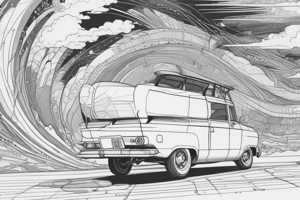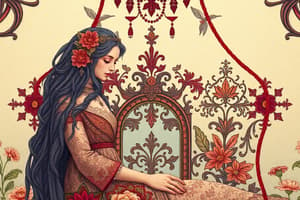Podcast
Questions and Answers
Which statement about lines is NOT accurate?
Which statement about lines is NOT accurate?
- Lines can be varying in thickness and direction.
- Lines can create shapes and patterns.
- Lines can express emotions and ideas.
- Lines can only be straight. (correct)
What distinguishes a shape from a form?
What distinguishes a shape from a form?
- Shape is three-dimensional, whereas form is two-dimensional.
- Shape is defined by curves only, while form is defined by angles.
- Shape lacks depth, while form includes depth and volume. (correct)
- Shape can only be geometric, while form can be organic.
How does value contribute to artwork?
How does value contribute to artwork?
- Value helps create volume and contrast. (correct)
- Value defines the geometric shapes in a composition.
- Value refers to the texture of the artwork.
- Value describes the hue of a color.
Which of the following best describes color harmonies?
Which of the following best describes color harmonies?
What is the role of light and shadow in form?
What is the role of light and shadow in form?
Which term refers to the surface quality of an object?
Which term refers to the surface quality of an object?
What is the significance of negative space in art?
What is the significance of negative space in art?
Which technique best describes the gradation of values?
Which technique best describes the gradation of values?
Flashcards
Line
Line
A mark that connects two points, can be straight, curved, or zigzagged.
Shape
Shape
A two-dimensional area defined by lines or other elements, can be geometric or organic.
Form
Form
A three-dimensional shape, created by adding depth and volume to shapes.
Value
Value
Signup and view all the flashcards
Color
Color
Signup and view all the flashcards
Texture
Texture
Signup and view all the flashcards
Positive Space
Positive Space
Signup and view all the flashcards
Negative Space
Negative Space
Signup and view all the flashcards
Study Notes
Line
- A line is a mark that connects two points.
- Lines can be straight, curved, or zigzagged.
- Lines can be used to create shapes, patterns, and textures.
- Lines can also be used to express emotions and ideas.
- Varying thicknesses and directions of lines can add visual interest.
Shape
- A shape is a two-dimensional area that is defined by lines or other elements.
- Shapes can be geometric (like squares, circles, and triangles) or organic (like free-form shapes).
- Shapes can be used to create patterns, textures, and volumes.
- Positive and negative shapes are relative terms that define the space between shapes as important as the shapes themselves.
- The use of shapes can convey different moods and feelings.
Form
- Form is a three-dimensional shape.
- Forms can be created by adding depth and volume to shapes.
- Forms can be geometric (like cubes and spheres) or organic (like free-form shapes).
- Light and shadow play a significant role in creating the illusion of form.
- Perspective techniques can enhance the sense of depth and form in a 2D drawing.
Value
- Value refers to the lightness or darkness of a color or tone.
- Value is used to create depth, dimension, and contrast in an artwork.
- Gradation of values helps create a sense of volume and realism.
- Chiaroscuro and sfumato are techniques that use value to create dramatic effects.
Color
- Color is a property of light.
- Color is often described with terms like hue, saturation, and value.
- Color can evoke emotions and moods in viewers depending on the use.
- Color harmonies such as analogous, complementary, and triad color schemes can be used in artistic compositions.
- Color theory explains the relationships between colors.
Texture
- Texture describes the surface quality of an object, either as seen or felt.
- Texture can be real (actual) or implied (visual).
- Actual texture can be rough, smooth, bumpy, etc.
- Implied texture uses visual cues to create the impression of a certain texture without the actual surface being that way.
- Texture adds visual interest and detail to artworks, creating a sense of depth and realism.
Space
- Space refers to the area around, between, or within shapes and forms.
- Space can be positive (the objects or forms themselves) or negative (the area surrounding them).
- Artists use various techniques to create the illusion of depth and space in two-dimensional artworks.
- Overlapping objects, linear perspective, and atmospheric perspective are techniques to create space.
- The use of space helps establish the scene within the artwork.
Studying That Suits You
Use AI to generate personalized quizzes and flashcards to suit your learning preferences.




